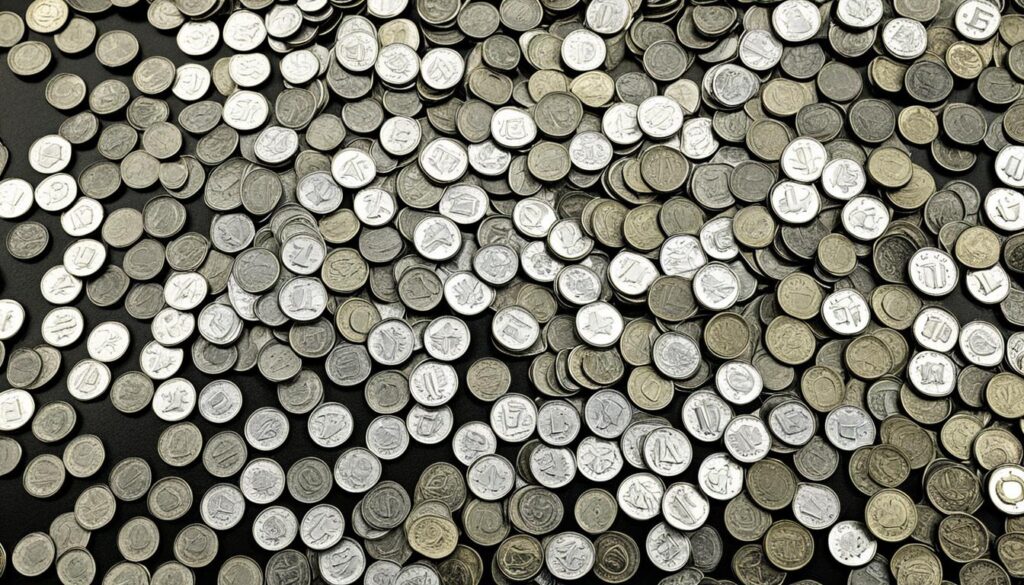Have you ever wondered how many zeros there are in a billion? Understanding large numbers is really exciting. A billion has exactly one 1 followed by nine zeros, so 1,000,000,000. What does this large number mean for us in everyday life? Discover the differences between a million and a billion.
Key findings
- One billion is represented as 1,000,000,000.
- The difference between a million and a billion is enormous: a billion seconds corresponds to approximately 31.7 years.
- Understanding large numbers can help you grasp complex mathematical concepts.
- Billion zeros : Nine zeros follow the number one.
- The number “billion” is an essential part of our economy and science.
Learn more about the mathematical peculiarities of a billion and its interesting comparisons! Stay tuned.
What is a billion?
A billion is the number 1,000,000,000. In Germany, we always write the word billion in capital letters. It helps us to better understand large numbers.
The word comes from the French „milliard“ . Its root is the Latin word „mille“ , which means „thousand“. A billion is the result of multiplying a thousand millions. This shows how big a billion really is.
In different languages, „billion“ has different meanings. But in mathematics and everyday life, the meaning is always the same. Understanding a billion is important for grasping large numbers.
Here you can see how numbers are called in German:
| Number | number word |
|---|---|
| 1,000 | Thousand |
| 1,000,000 | One million |
| 1,000,000,000 | One billion |
When you know what a billion means, you understand how important it is. It plays a big role in business and science. The word „billion“ makes big numbers easier for us.
Mathematical Properties of a Billion
A billion is quite impressive because of its mathematical properties . There are many ways to represent and analyze it, which makes it very exciting for mathematicians.
power of ten
A billion is expressed as a power of ten , 10⁹. That is, the number 1 is written with nine zeros: 1,000,000,000. This is particularly useful in science and when dealing with very large numbers.
cubic number
The billion is also a cube number . More precisely, it is 1000³. This shows how the number is created from a cube of 1000. This idea helps to make three-dimensional calculations easier.
even number

Furthermore, a billion is an even number . It can be divided by two. All even numbers follow the formula 2n, where n is an integer. A billion fits exactly into these rules.
Comparison of millions and billions
Millions and billions make a big difference when measured in seconds. Comparing them over time helps to understand the magnitude of both numbers.
Example with seconds
11 days are actually a million seconds. A billion seconds, on the other hand, are a full 31.7 years. This shows how much bigger a billion is compared to a million.
| Number | period in seconds | Conversion in days | Conversion in years |
|---|---|---|---|
| 1 million | 1,000,000 | 11.57 days | 0.032 years |
| 1 billion | 1,000,000,000 | 31,709.79 days | 31.7 years |
The comparison clearly shows the huge difference between millions and billions. By analyzing billions vs. millions, the gigantic time difference between these numbers becomes visible.
representation of large numbers
Large numbers are easier to understand if they are well represented. Notation and the place value system are important. We will look at various techniques.
spellings
Dividing numbers into sections makes them easier to read. For example, you can divide large numbers with spaces or periods. So you write 1,000,000,000 instead of 10000000000. Or you say „a billion“ instead of writing lots of zeros.

place value table
A place value table shows where each digit is in a number. This is very helpful with large numbers. It allows us to easily see the importance of each position.
| power of ten | importance | number |
|---|---|---|
| 10 9 | billion | 1 |
| 10 8 | one hundred million | 0 |
| 10 7 | Ten million | 0 |
| 10 6 | million | 0 |
| 10 3 | Thousand | 0 |
| 10 0 | One | 0 |
This makes the number 1,000,000,000 clear and its structure easy to understand.
Examples to imagine a billion
We find it difficult to comprehend the magnitude of a billion. But with a few examples, the number becomes tangible. For example, you can stack sheets of paper to illustrate it.
If you stack a billion sheets of paper, the tower will be almost 297,000 kilometers high. That’s almost as far as the moon. That shows how huge a billion is.

Another example concerns volume. A cubic meter, divided into small cubic millimeter cubes, holds a billion of these cubes. This idea helps us to understand the enormous number.
| Number | Description |
|---|---|
| 1,000,000,000 | Sheets of paper stacked on top of each other almost reach the moon. |
| 1,000,000,000 | Millimeter cubic cubes in a cubic meter. |
Historische Verwendung der Milliarde
Die Hyperinflation spielte in der Geschichte der Milliarde eine wichtige Rolle. 1923 war Deutschland von extremer Währungsinflation betroffen. Dadurch waren Banknoten mit dem Wert von einer Milliarde Mark im Umlauf.
Die Geschichte der Milliarde zeigt uns, wie Hyperinflation den Wert des Geldes beeinflussen kann. Damals sank der Geldwert fast jeden Tag. Größere Beträge mussten gedruckt werden, um den Verlust auszugleichen.
Um den historischen Kontext der Währung Inflation besser zu verstehen, schauen wir uns eine Tabelle an:
| Jahr | Ereignis | Relevanz |
|---|---|---|
| 1923 | Deutsche Hyperinflation | Banknoten mit Milliardenbetrag im Umlauf |
| 1946 | Ungarische Hyperinflation | Währungswechsel zur Stabilisierung |
Die Geschichte der Milliarde zeigt uns, wie Wirtschaftsentwicklungen Geld beeinflussen. Es ist ein klarer Beweis, wie der Wert von Geld sich ändern kann.
Die Zahl 1.000.000.000 in verschiedenen Zahlensystemen
Die Zahl 1.000.000.000 bedeutet eine Milliarde. Sie kann auf verschiedene Arten dargestellt werden. Wir schauen uns das im Dualsystem, Oktalsystem und Hexadezimalsystem an.
Dualsystem
Im Dualsystem, wichtig für Computer, steht die Milliarde als 111011100110101100101000000000. Das zeigt, wie das System mit 1 und 0 arbeitet.
Oktalsystem
Das Oktalsystem nutzt die Basis 8. Es benutzt Zahlen von 0 bis 7. Hier wird eine Milliarde als 7346545000 dargestellt.
Diese Form ist einfacher als im Dualsystem. Sie wird oft in Technikbereichen genutzt.
Hexadezimalsystem
Das Hexadezimalsystem gebraucht die Basis 16. Es verwendet Ziffern und Buchstaben von A bis F. Eine Milliarde ist hier 3B9ACA00.
Dies ist nützlich in der Computerwelt. Es vereinfacht die Darstellung großer Zahlen.
| Zahlensystem | Darstellung von 1.000.000.000 |
|---|---|
| Dualsystem | 111011100110101100101000000000 |
| Oktalsystem | 7346545000 |
| Hexadezimalsystem | 3B9ACA00 |
Rechenbeispiele zur Milliarde
Mathematische Beispiele machen es einfacher, die Größe einer Milliarde zu verstehen. Schauen wir uns ein paar Beispiele an.
Flächenberechnung
Stellen Sie sich vor, eine Milliarde kleine Stahlkugeln würden nebeneinander gelegt. Sie hätten einen Durchmesser von einem Millimeter. Diese Kugeln würden dann 1000 Quadratmeter bedecken.
Gewichtsberechnung
Jetzt eine Gewichtsberechnung: Eine Milliarde kleine Stahlkugeln wiegt rund 4,2 Tonnen. Wenn man sie in eine Linie legt, wäre diese 1000 Kilometer lang.
Das entspricht der Entfernung von München nach Rom. Diese Beispiele vermitteln einem ein Gefühl für die Zahl eine Milliarde.
Unterschiede zwischen deutscher und amerikanischer Bezeichnung
In Deutschland und den USA nennt man große Zahlen anders. Bei uns heißt 1.000.000.000 eine Milliarde. In den USA wird das als „billion“ bezeichnet. Das führt oft zu Verwechslungen.
In Deutschland sagen wir zu 1.000.000.000.000 Billion. In Amerika nennt man das eine „trillion“. Diese Unterschiede können in der Übersetzung zu Fehlern führen. Es ist wichtig, auf die Sprachversion zu achten, um Missverständnisse zu vermeiden. Besonders in der Wissenschaft und bei internationalen Projekten ist das wichtig.
Die verschiedenen Zählweisen beeinflussen auch den Alltag. Zum Beispiel in den Nachrichten oder in Finanzberichten. Eine klare Kommunikation ist wichtig, um Verwirrung zu verhindern. Es hilft, sich mit den Zahlennamen auseinanderzusetzen. Und auf ihre Bedeutung in jeder Kultur hinzuweisen.
FAQ
Wie viele Nullen hat eine Milliarde?
Was ist eine Milliarde?
Was sind die mathematischen Eigenschaften einer Milliarde?
Wie unterscheiden sich Millionen und Milliarden zeitlich?
Wie kann man große Zahlen besser darstellen?
Gibt es praktische Beispiele, um die Größe einer Milliarde zu verstehen?
Welche historische Bedeutung hat die Milliarde?
Wie sieht die Zahl 1.000.000.000 in verschiedenen Zahlensystemen aus?
Wie könnte man eine Milliarde mit Flächen- und Gewichtsberechnungen veranschaulichen?
Was ist der Unterschied zwischen der deutschen und amerikanischen Bezeichnung für große Zahlen?





